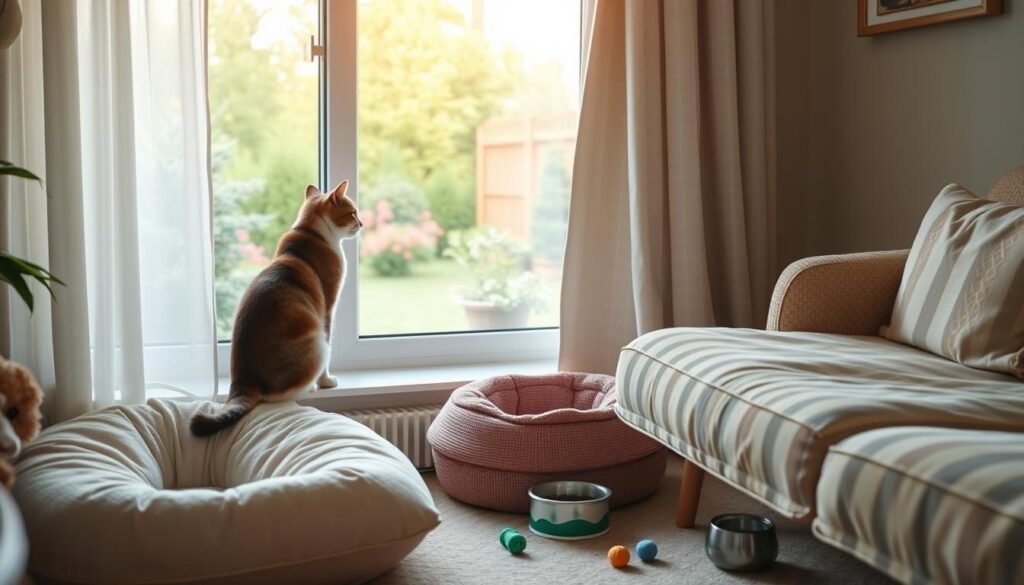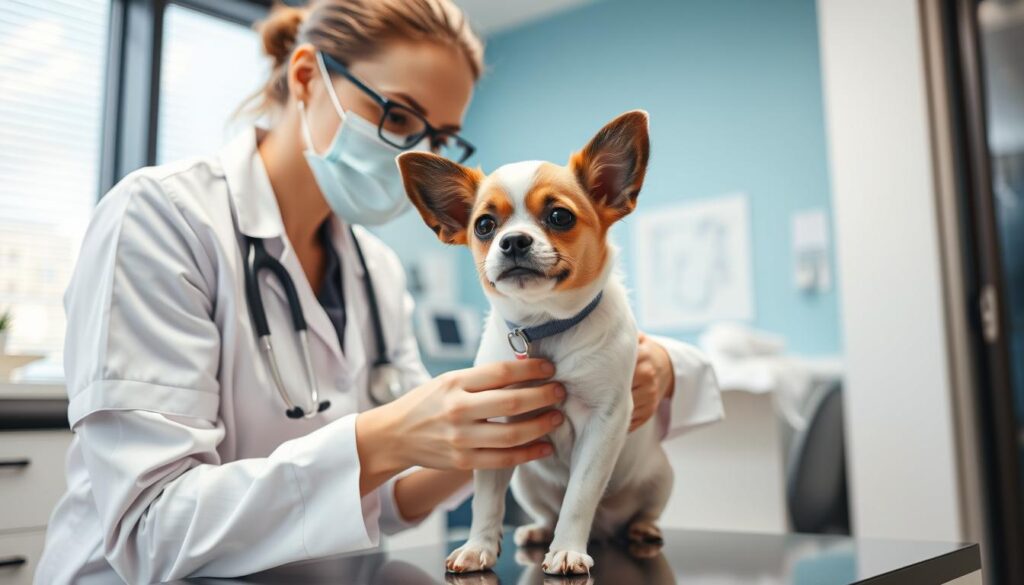How to Spot Signs of Stress in Indoor Pets

As a pet owner, you want your furry friends to be happy and healthy. However, pets can experience stress and anxiety just like humans do. The concerning fact is that nearly 80% of pets in the UK suffer from anxiety, with 11% of dogs showing signs of stress when left alone.
March is recognized as Pet Anxiety month, raising awareness about the stress issues your pets might be facing. Recognizing the signs of stress is crucial for their overall health and wellbeing. Different types of pets exhibit different stress signals, and early detection can prevent more serious behavioral and health problems.
You can play a vital role in identifying these signs and taking appropriate action to ensure your pet leads a comfortable life.
Understanding Pet Stress and Its Impact
Understanding the impact of stress on pets is crucial for maintaining their health and happiness. As a pet owner, you play a significant role in your pet's emotional wellbeing. Being calm and composed can help mirror a calm state in your pet.
Stress can manifest in various ways, affecting your pet's overall health. Chronic stress can have severe consequences, including a weakened immune system, digestive issues, and exacerbated health conditions.
Why Indoor Pets Are Prone to Stress
Indoor pets are particularly susceptible to stress due to their environment and lack of stimulation. Factors such as lack of exercise, changes in routine, and social factors can contribute to their stress levels.
The Connection Between Stress and Health Problems
The link between stress and health problems in pets is significant. Chronic stress can lead to various issues, including:
- Suppressed immune systems, making pets more vulnerable to illnesses
- Digestive problems, such as Irritable Bowel Disease (IBD) in cats and dogs
- Exacerbation of existing health conditions or the onset of new ones
- Behavioral problems rooted in stress-related issues
- Recurring health issues if underlying stress is not addressed
| Stress Impact | Health Consequences |
|---|---|
| Chronic Stress | Weakened Immune System |
| Digestive Stress | IBD, Loss of Appetite |
| Behavioral Stress | Anxiety, Destructive Behavior |
Common Causes of Stress in Indoor Pets
Several common stressors can affect the mental health of your indoor pets. These stressors can be broadly categorized into environmental changes, routine disruptions, and social factors.
Environmental Changes
Changes in your environment, such as moving house or loud noises from fireworks, can cause significant stress for indoor pets.
Routine Disruptions
Drastic changes to their routine can also be stressful. This includes trips to the kennels, cattery, or vet.
Social Factors
The addition of new members to your household, such as another pet or a baby, can create stress. New people, visitors, or parties can overwhelm sensitive pets. Changes in family structure, like divorce or children leaving, also impact pets. Even seeing outdoor animals through windows can be a source of stress.
Physical Signs of Stressed Indoor Pets
Recognizing the physical signs of stress in your indoor pets is essential for maintaining their health. Stress can affect your pet's overall well-being, leading to various physical symptoms.
Changes in Appetite and Eating Habits
Stress can cause a shift in your pet's eating habits. Just like humans, pets may lose their appetite when anxious or comfort eat when feeling overwhelmed. Monitoring their food intake is crucial to identify any drastic changes. A change in appetite can be an early sign of stress or underlying health issues.
Digestive Issues and Physical Symptoms
Stress often manifests as digestive upset in pets, leading to symptoms like vomiting or diarrhea. Chronic stress can result in ongoing digestive problems, affecting your pet's overall health. Other physical symptoms include excessive shedding, dandruff, or changes in their coat. If these symptoms persist, it's essential to consult a veterinarian to rule out underlying conditions.
- Digestive issues can be a direct result of stress, impacting your pet's quality of life.
- Anxiety can cause physical symptoms that require attention and proper management.
- Monitoring your pet's physical condition and behavior is key to identifying stress early.

Behavioral Signs of Stress in Dogs
Recognizing the behavioral signs of stress in dogs is crucial for providing the right support and care. Dogs under stress can exhibit a range of behaviors that may be confusing or concerning for their owners.
Body Language Indicators
Dogs often display specific body language cues when they are stressed. According to Dogs Trust, some common indicators include slowing down, leaning away, lip-licking, and crouching. An 'appeasement grin' or 'submissive grin' can also be a sign of anxiety. Paying attention to these subtle cues can help you identify stress early.
Unusual Behaviors to Watch For
Stressed dogs may also exhibit more overt behaviors such as shaking, panting, pacing, jumping, pawing, or mouthing. Some dogs become clingy, while others may withdraw. Stress can trigger resource guarding or defensive behaviors. Additionally, house-trained dogs may have accidents when anxious. Monitoring these behaviors can help you understand your dog's stress levels.
- Excessive barking or whining can be a clear indicator of anxiety in dogs.
- Pacing, spinning, or an inability to settle are common stress indicators.
- Some dogs may become more clingy, while others may withdraw when stressed.
- Stress can lead to resource guarding or defensive behaviors in dogs.
- Even house-trained dogs may have accidents when they are feeling anxious.
Recognizing Stress in Indoor Cats
As a cat owner, recognizing the signs of stress in your feline companion is essential for their well-being. Indoor cats, in particular, can exhibit subtle stress indicators that may easily go unnoticed.
Litter Box Issues and Territory Marking
Stressed cats may exhibit litter box issues, such as hesitating to use the litter tray or outside litter areas. Territory marking, including scratching furniture, can also be a sign of feline stress.
Changes in Social Behavior
Changes in social behavior are common in stressed cats. They may become more withdrawn or, conversely, more clingy. Some cats may display aggression when anxious, while others may alter their interaction patterns with other household pets.
Identifying Anxiety in Small Pets
As prey animals, small pets often hide signs of stress, making it crucial to recognize the subtle indicators. You can identify anxiety in your small pets by observing changes in their behavior and physical condition.
Guinea Pigs and Rabbits
Guinea pigs and rabbits may exhibit stress through behaviors like bar-chewing or excessive digging. These actions can be a sign that they are feeling anxious or uncomfortable in their environment. Monitoring their behavior closely can help you identify potential issues early on.
Hamsters, Gerbils, and Other Small Mammals
Hamsters, gerbils, and other small mammals may display anxiety in different ways. For instance, hamsters may stuff their cheek pouches excessively when anxious, while gerbils may become unusually aggressive or withdrawn. Changes in sleep patterns can also indicate stress in nocturnal animals. Additionally, small mammals may develop repetitive behaviors when chronically stressed.
Some common signs of anxiety in small pets include:
- Low energy levels
- Reduced appetite
- Hiding or avoiding social interaction
- Excessive bar-chewing or digging
- Changes in sleep patterns
By being aware of these signs and taking steps to address them, you can help reduce your small pet's anxiety and create a more comfortable living environment.
Destructive Behaviors as Stress Indicators
Indoor pets experiencing stress may resort to destructive behaviors, signaling a need for intervention. These actions can range from chewing on furniture to urinating outside the litter box.
Excessive Chewing and Scratching
Pets, especially dogs, may engage in excessive chewing on household items when they're under stress. Similarly, cats may exhibit excessive scratching or grooming behaviors.
Self-Destructive Behaviors
Some pets may direct their stress behaviors toward themselves, leading to self-destructive actions. Over-grooming can result in bald spots or skin damage. Compulsive chewing or licking of paws and tails can also occur, potentially leading to self-mutilation, which requires immediate veterinary attention.
| Behavior | Possible Cause | Action Required |
|---|---|---|
| Excessive Chewing | Stress, Anxiety | Provide Chew Toys, Training |
| Over-Grooming | Stress, Skin Issues | Veterinary Check-up, Reduce Stress |
| Urinating Outside Litter Box | Stress, Medical Issues | Litter Box Maintenance, Veterinary Check-up |
Creating a Stress-Free Environment for Your Pet
To keep your pet happy and healthy, it's essential to minimize stress in their environment. This involves creating a comfortable and secure space within your home.
Safe Spaces and Hideaways
Give your pets places to escape for a break, especially if you have a lot going on in your home. Designate their favorite spot as a place where others don't bother them. This helps build their resilience to cope with high levels of social interaction.
Reducing Environmental Stressors
To reduce stress, consider the following:
- Minimize noise pollution that can stress sensitive pets.
- Maintain consistent lighting and temperature for pet wellbeing.
- Use pheromone products to create a calming atmosphere.
- Arrange furniture to create pet-friendly traffic patterns.
- Manage visual stressors like seeing outdoor animals.
Calming Strategies for Stressed Indoor Pets
Indoor pets often exhibit stress due to various factors, and it's crucial to identify the right calming techniques to help them feel better. By understanding and implementing effective strategies, you can significantly reduce your pet's stress levels.

Physical Exercise and Mental Stimulation
Engaging your pet in regular physical exercise and providing mental stimulation can help alleviate stress. Activities such as walks, playtime, and interactive toys can keep your pet occupied and calm.
Calming Products and Supplements
Various calming products and supplements are available to help reduce pet stress. Pheromone diffusers and sprays, such as ADAPTIL and FELIWAY, mimic natural calming signals, creating a soothing environment for your pet. Pressure wraps like Thundershirts can also be effective for anxious pets. Additionally, calming music or white noise can help mask stressful sounds.
Some pet owners find natural supplements helpful in reducing their pet's anxiety. However, it's essential to consult with a veterinarian before introducing any new supplements or medications, especially if considering prescription anti-anxiety medications. For more information on managing anxiety in pets, you can visit Safford Vets.
Maintaining Routines to Reduce Pet Anxiety
To help your pet feel more secure, establishing a predictable routine is essential. A consistent daily schedule can significantly reduce stress and anxiety in indoor pets. By maintaining a routine, you provide your pet with a sense of stability and normalcy.

Consistent Feeding and Care Schedules
A regular feeding schedule helps regulate your pet's digestive system and reduces anxiety related to meal times. Consistent care schedules, including regular grooming and exercise, also contribute to your pet's overall well-being.
Predictable Social Interactions
Engaging in daily interactions with your pet through play, petting, or grooming can help strengthen your bond and reduce anxiety. Predictable greeting and departure routines can also help minimize stress caused by your comings and goings. Scheduled play and training sessions benefit your pet's emotional health, while predictable handling and interaction build trust.
When to Seek Professional Help

If your pet is experiencing stress, it's crucial to know when to seek professional help. Your vet is the first point of contact to rule out any underlying medical issues that could be causing your pet's stress or anxiety.
Signs That Require Immediate Veterinary Attention
Some signs of stress in pets require immediate attention from a veterinarian. These include sudden changes in appetite, vomiting, diarrhea, or signs of pain.
Working with Animal Behaviorists
A certified animal behaviorist can help identify the triggers of your pet's stress and develop a treatment plan. They differ from trainers in their approach, focusing on understanding and addressing the root cause of the behavioral issue.
- Discuss how certified animal behaviorists differ from trainers: They are professionals with expertise in animal behavior and learning theory.
- Explain the process of behavioral assessment and treatment planning: It involves observing your pet's behavior, identifying triggers, and developing strategies to address these triggers.
- Highlight how behaviorists can identify triggers you might have missed: Their expertise allows them to notice subtle changes or patterns that you might not be aware of.
- Mention what to expect during behavior modification therapy: You can expect guidance on how to implement changes in your pet's environment and interactions to reduce stress.
- Explain how to find qualified professionals for your specific pet species: Look for certified animal behaviorists through professional organizations or ask your vet for recommendations.
Stress Prevention: Long-Term Strategies
Implementing long-term strategies is crucial for preventing stress in your pets. By adopting a proactive approach, you can significantly reduce the likelihood of stress-related issues in your indoor pets.
Early Socialization and Training
Socializing your young kitten is a crucial step in helping them learn to accept new people, pets, and experiences, and becoming more resilient in response to stressful events. Early socialization and training play a vital role in shaping your pet's behavior and reducing anxiety.
Regular Health Monitoring
Regular health monitoring is essential for identifying potential health issues before they become major problems. This includes:
- Preventative healthcare to reduce physical stressors
- Regular check-ups to catch stress-related issues early
- Pain management to prevent discomfort and stress
- Dental care to maintain overall comfort and reduce stress levels
- Weight management to contribute to emotional wellbeing
| Health Monitoring Aspect | Benefits for Pet Health |
|---|---|
| Preventative Healthcare | Reduces physical stressors and prevents illnesses |
| Regular Check-Ups | Catches stress-related issues early, improving treatment outcomes |
| Pain Management | Prevents discomfort and stress caused by unmanaged pain |
| Dental Care | Maintains overall comfort and reduces stress levels |
| Weight Management | Contributes to emotional wellbeing by preventing obesity-related issues |
Conclusion: Creating a Happy Home for Your Indoor Pet
A calm and happy pet is a direct result of a stress-free living environment, which you can help create. By recognizing the signs of stress in your indoor pet and implementing strategies to reduce it, you can significantly improve their happiness and health. Different pets exhibit stress differently, but all deserve a supportive and nurturing environment. Creating a low-stress home is one of the greatest gifts you can give your pet, enhancing both their quality of life and your bond with them. With patience and consistency, you can help your pet feel more relaxed and happy.
By being your pet's best advocate and taking proactive steps to manage their stress, you not only improve their well-being but also contribute to a longer, healthier life for them. Implementing the strategies discussed throughout this article will help you achieve this goal. Remember, understanding your pet's stress signals is an ongoing process that requires attention and care. Your efforts will be rewarded with a happier, healthier pet.

Leave a Reply